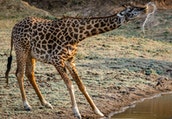- 1. Africa Black Wildebeest (Connochaetes gnou):
- Appearance: Black wildebeests have a more slender and horse-like appearance compared to their blue counterparts. They have a dark brown to black coat, a white beard on their throats, and a long, horse-like mane along their neck.
- Population: Black wildebeests are less numerous and have a more limited distribution, mainly found in South Africa, Lesotho, and Namibia.
- Behavior: Black wildebeests are not migratory like the blue wildebeests, and they tend to remain in their home ranges year-round.
- 2. Blue Wildebeest (Connochaetes taurinus):
- Appearance: Blue wildebeests have a robust, heavily built body with a hump on their shoulders. They have a dark gray to bluish-black coat, a black mane, and a beard of long hair on their throats. Their legs are slender and end in cloven hooves.
- Population: The blue wildebeest is the most numerous and widespread wildebeest species, found in countries such as South Africa, Namibia, Botswana, Zimbabwe, Tanzania, Kenya, and others.
- Behavior: Wildebeests are migratory animals and undertake one of the most significant wildlife migrations on the planet. The Serengeti-Mara ecosystem hosts the Great Wildebeest Migration, where millions of wildebeests, along with zebras and other herbivores, move in search of fresh grazing and water.
- 3. Africa Wildebeest Reproduction: Wildebeests give birth to a single calf after a gestation period of about eight and a half months. Calves can stand and walk within a few minutes after birth, allowing them to keep up with the moving herds.
- 4. Africa Wildebeest Diet: Wildebeests are primarily grazers, feeding on grass and other vegetation. Their diet includes a variety of grass species that grow in their habitats.
- 5. Africa Wildebeest Habitat: Wildebeests prefer open grasslands, savannas, and woodlands. They are well-adapted to a wide range of environments, making them successful and highly adaptable herbivores.
- 6. Africa Wildebeest Predators: Wildebeests are prey to a variety of predators, including lions, hyenas, leopards, cheetahs, and crocodiles during river crossings.
Africa Wildebeest
The wildebeest, also known as the gnu, is a distinctive and iconic antelope species found in various regions of Africa. There are two species of wildebeest: the Blue Wildebeest (Connochaetes taurinus) and the Black Wildebeest (Connochaetes gnou).
Africa Safari Tour Book online Witnessing the wildebeest herds on their epic journey is not only a thrilling safari adventure but also a humbling reminder of the beauty and complexity of the African wilderness.
Here are some key points about the African wildebeest:
Africa Wildebeest Safari Tour
An Africa wildebeest safari tour offers a front-row seat to one of the most awe-inspiring natural spectacles on the planet—the Great Wildebeest Migration. This migration involves millions of wildebeests, along with zebras and other herbivores, moving across vast distances in search of fresh grazing and water.
By planning ahead and choosing reputable safari operators or guides, The Great Wildebeest Migration is a natural wonder that should be experienced at least once in a lifetime. It is an excellent example of the cyclical nature of nature and the interconnectedness of ecosystems.
Here are some key points to consider when planning an Africa wildebeest safari tour:
Africa Wildebeests Safari Destinations
Safari Destinations: The Great Wildebeest Migration takes place in the Serengeti-Mara ecosystem, which spans parts of Tanzania and Kenya. Some of the best safari destinations to witness the migration include:
- Serengeti National Park (Tanzania): The Serengeti is the heart of the migration, and different parts of the park offer opportunities to witness different stages of the journey.
- Maasai Mara National Reserve (Kenya): The Maasai Mara is where the wildebeests cross the Mara River, one of the most dramatic and perilous parts of their migration.
Africa Wildebeest Timing
Timing: The timing of the migration varies each year, as it is dependent on rainfall and the availability of fresh grazing. Generally, the wildebeests start moving north from the Serengeti to the Maasai Mara around July and return to the Serengeti around October. However, these timings can fluctuate, so it's essential to plan your safari accordingly.
Africa Wildebeest Guided Game Drives
Guided Game Drives: Participate in guided game drives led by experienced safari guides who are familiar with the migration patterns and behavior of wildebeests. Game drives offer excellent opportunities to witness the wildebeest herds up close and observe the accompanying predators and other wildlife.
Africa Wildebeest River Crossings
River Crossings: Witnessing wildebeests attempting to cross crocodile-infested rivers, like the Mara River, is one of the most dramatic and intense moments of the migration. Safaris in the Maasai Mara during the river crossing season offer a chance to witness this spectacle.
Africa Wildebeest Hot Air Balloon Safaris
Hot Air Balloon Safaris: Consider adding a hot air balloon safari to your itinerary for a unique and breathtaking perspective of the vast herds and the Serengeti or Maasai Mara landscapes.
Africa Wildebeest Photography Opportunities
Photography Opportunities: Bring a camera with a zoom lens to capture the incredible wildlife sightings, including the mass movement of wildebeests during the migration.
Africa Wildebeest Wildlife Diversity
Wildlife Diversity: While on your wildebeest safari, you will encounter a diverse range of wildlife, including lions, cheetahs, leopards, elephants, giraffes, and various bird species.
Africa Wildebeest Responsible Tourism
Responsible Tourism: Choose safari operators and lodges that prioritize responsible and sustainable tourism practices, ensuring the well-being of wildlife and the preservation of the delicate ecosystems.








 |
|  |
|  |
|  |
| 